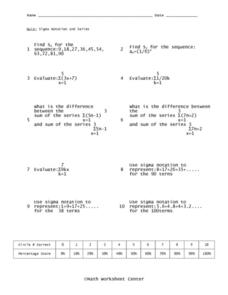Curated OER
Creating Fractals
Students solve problems using fractals. In this geometry lesson, students identify properties of fractals. They find patterns in their surroundings and relate it to the real world and math.
Curated OER
Skipping Into Multiplication
Young mathematicians study the relationship between skip counting and multiplication. They build on skip counting skills and examine arrays while studying multiplication. Resources are provided.
Inside Mathematics
Graphs (2006)
When told to describe a line, do your pupils list its color, length, and which side is high or low? Use a worksheet that engages scholars to properly label line graphs. It then requests two applied reasoning answers.
Curated OER
Using Rhythm Instruments to Tell a Story
After watching a video of Peter and the Wolf, and identifying the instruments used to represent each character, class members use rhythm instruments to represent the actions in the song, "What Would I do."
Curated OER
Comparing Arithmetic and Geometric Sequences
In this algebra worksheet, students analyze patterns and identify it as arithmetic, geometric, or neither. There are 30 questions with answers.
Howard Hughes Medical Institute
Tracking Genetically Modified Mosquitoes
What's that buzzing in your ear? An insightful lesson about genetically modified mosquitoes! Partnered pupils explore the creation, release, and monitoring of mosquitoes designed to reduce the mosquito population. After watching a video,...
Curated OER
Anthony's Allowance
In this problem solving worksheet, students read one problem about a boy who saves a specified amount of money each day. Students identify the pattern and answer the questions.
Curated OER
Rotations in the Plane
Pupils investigate the properties of a rotation as they use technology (Cabri, Jr.) to observe the relationship between the pre-image and the image formed by the rotation. The lesson provides ample opportunity for learners to conjecture...
Curated OER
Sigma Notation and Series
In this sigma notation and series worksheet, 11th graders identify and complete 10 different problems that include determining the sigma notation and series of each problem. First, they determine the sequence in each given a set of...
Curated OER
Interpreting and Displaying Sets of Data
Students explore the concept of interpreting data. In this interpreting data lesson, students make a line plot of themselves according to the number of cubes they can hold in their hand. Students create their own data to graph and...
Curated OER
Shaping Up!
Kindergartners are introduced to basic shapes. Learners spend 45 minutes a day in geometry centers carrying out the activities outlined in this ambitious plan. There are games, hands-on activities, interactive websites, art projects,...
Curated OER
Understanding 10: Backwards and Forwards
Help your young mathematicians completely master 10 by practicing one-to-one correspondence, number recognition, and recording numbers displayed. They make 10 with groups of two-different colored cubes and color in 10-frames to show how...
Curated OER
Plant Diversity and Distribution
Learners construct a defined plot on school grounds and observed patterns in plant life. They count trees, shrubs, cacti and record on a data sheet. They compare data and generate a plant diversity overlook for their school.
Curated OER
A Honey of a Hexagon
Students explore how bees make honey and why the hexagon is the best basic pattern for the honeycomb through the use of a video and hands-on activities with honeycombs and geometric shapes.
Curated OER
Where Am I, and How Do I Get Where I am Going?
Students describe geographical places through art, music, writing, and math. They compile information in booklets which may be published.
Curated OER
Adding 10
A total of 50 basic addition problems are contained with in this worksheet. Your class can hone their math skills by adding 10 to a variety of numbers. Tip: When they are done have them discuss and identify any patterns they can find.
DK Publishing
Big, Bigger, Biggest
Which water creature is the biggest? Youngsters look at an image of a big shell, then draw a bigger shell next to it. They do the same for a big fish. Next, learners practice with the superlative as they circle the biggest duck and frog....
Curated OER
Graphing Linear Functions
Seventh graders identify the use of a function.They are asked to describe the input and output of a function. Students also identify different aspects of the coordinate system and represent functions in a visual graph.
Curated OER
Quilt Geometry
Seventh graders explore lines of symmetry, congruent polygons and patterns. They listen to "The Seasons Sewn," observe a PowerPoint presentation, and identify congruent polygons and visual patterns. Through an internet activity, 7th...
Curated OER
Ten Little Black Dots
Second graders use black and red construction paper to symbolize different one digit numbers that add up to 10. In this sums to 10 lesson plan, 2nd graders discover different combinations and patterns that can lead them to the number 10.
Curated OER
Even and Odd Numbers
First graders use patterns in order to identify and recognize even and odd numbers.
Curated OER
Snowflake Curve
Students develop an appreciation for complex structures in nature. They observe patterns in nature in relationship to the Real World. Students use observation skills to assist in problem solving. They show comprehension of the concepts...
Curated OER
Music
First graders identify ways in which math and language arts relate to their music. After being read a book, they sing a song about who took the cookies from the cookie jar. They recognize repeated patterns in the melody and rhythm and...
Curated OER
Tessellations
Students identify shapes that will tessellate. They construct a tessellation using transformations. Students identify transformations in tessellations. They identify applications of transformations such as tiling and fabric design.

























